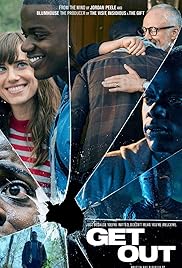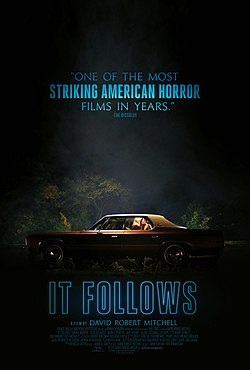In the past couple years, horror movies have been winning critical acclaim and adoration, bringing the genre more and more into the realm of high culture. In particular, Hush, Get Out, and It Follows come to mind; none of them utilize cheap thrills to get a quick scare, but all of them are excellent for their writing, characters, and plot execution.
**Spoiler Warnings For All Films Mentioned**
In Hush, the main character, Maddie, is a deaf and mute writer who lives alone to the discomfort of both her family and her neighbors, who constantly reach out to her. She is capable and competent, and chooses to live the way that she wishes with the help of the technology that is available to her.
The beginning of the movie lays the foundation of Maddie's life in silence, showing that she gets along quite nicely on her own, cooks her own meals, and communicates with her friends and family via text message. Her neighbor, Sarah, comes over to visit, and talks to Maddie using sign language that she is attempting to learn because she values Maddie's opinion and wishes to speak with her more freely. The two of them have a conversation about Maddie's newest book, making Maddie forget all about the food that she was making earlier. The smoke alarm goes off as her lamb chops burn, and Maddie asserts that it must be loud enough to vibrate the house, so that it will shake her awake if the house catches fire when she is asleep.
After Sarah leaves, Maddie goes about her business. She does not notice or hear Sarah screaming outside for help as she is murdered. The killer is intrigued, and enters the house without Maddie knowing. The suspense reaches critical heights here, and Maddie only becomes suspicious of another person in her house because she calls her sister on FaceTime and she mentions seeing something in Maddie's kitchen. The killer then takes Maddie's phone and snaps a picture of her while she is on her computer, which she receives over iMessage. Maddie, reasonably so, is terror-stricken, and begins to investigate.
The killer is cruel and unrelenting, and as soon as he finds out that Maddie is deaf, tortures her by lingering around her premises. He cuts off the power, has her cell phone, traumatizes her by throwing around Sarah's inanimate corpse, and maintains the upper hand most of the film because he has all five senses. She cannot scream for aid, call the police, or seek help conventionally because she needs to use FaceTime and ASL in order to communicate. However, Maddie uses his ability to hear against him, setting off her car alarm and the overwhelming smoke alarm, hiding out of sight, and using every resource available to her in order to take him down.
The movie portrays her struggles as entirely human and accessible, instead of commodifying her disability for distasteful humor. She is a brave character, opening up the locked windows of her home to steal the killer's cross bow. At the end of the movie, she even accepts her own death like a warrior returning to battle, writing a goodbye letter on her computer, telling her family that she died fighting. Maddie is victorious because of her intellect and ability to, as a writer, play through different possible scenarios and endings for her characters and herself. She assesses her situation, and is called to action, planning her moves ahead of time. Hush, quite literally, gives a powerful voice to a woman who is unable speak.
 Jordan Peele's thought-provoking addition to horror cinema, Get Out, empowers its characters in its critique of racial injustice and societal microaggressions. The movie opens with a black man being kidnapped by a man in an armored mask as he nervously walks through a suburban street, criticizing the stereotypical narrative of white people being afraid if a person of color enters their neighborhood.
Jordan Peele's thought-provoking addition to horror cinema, Get Out, empowers its characters in its critique of racial injustice and societal microaggressions. The movie opens with a black man being kidnapped by a man in an armored mask as he nervously walks through a suburban street, criticizing the stereotypical narrative of white people being afraid if a person of color enters their neighborhood.The movie then cuts to a biracial couple; a black man named Chris and his white girlfriend, Rose, are packing up to go on a trip to her parent's house. Chris expresses his anxiety about meeting her parents because of his race, and she comforts him about it, telling him that they would have voted for Obama for a third term, if they were allowed to.
Rose's parents, at a glance, seem to be warm and inviting to him, yet there is something uncanny lurking beneath the surface. All of their household workers are black; Rose's dad acknowledges the awkwardness, telling Chris to disregard appearances. Then, Rose's mom hypnotizes Chris against his will under the guise of helping him quit smoking cigarettes, leading him to temporarily become a prisoner in his own body. Rose's family has a party, filled with old white people making comments on Chris' body being strong and limber, making Chris extremely uncomfortable. He picks up on the strange behavior by talking to the black maid and groundskeeper, whose way of speaking is eerily robotic and calculated. Eventually, the man that was kidnapped at the beginning of the movie is shown to be married to an elderly white woman, Chris takes a picture of the man with flash photography to send to his friend, and he breaks out of his apparent hypnosis, screaming at Chris to "GET OUT." After a bunch of sketchy misdirection by the family and an auction scene meant to emulate the slave trade, Chris uncovers that Rose is a succubus-type that dates black men and women to capture them, and her brother, the man in the armored mask, helps by knocking out strangers and bringing them back to the house. Rose's family then performs an operation to put their dying white relative's souls into the bodies of these black men and women, so that they may live on forever. Chris narrowly escapes with the help of his intuition and his friend, leaving the house to burn, and all of the evidence with it.
The film successfully illustrates tensions that run under the surface—the tensions that most people are not aware of or refuse to admit are indicative of prejudice. None of the white characters within the movie are blatantly hateful, but all of them view black people as inhuman; they are viewed as mere vessels to further the white existence and identity, and only viewed as useful because of what they can do for the family. The film, along with showing the more satirical aspects of racial politics, highlights the objectification inherent to racism, and how people think they can escape their hypocritical ignorance by voting Obama for president for a fictional third term, or having a friend or significant other of a different race.
The film aims to show how disjointing, cruel, and unnatural it is for a person of color's identity to be stolen, their culture to be erased, and their mannerisms to be "whitened." Get Out is powerful. No, the "white nightmare" narrative is not offensive to me. White people will always benefit from systems of white supremacy, whether or not they are complacent with, ignorant of, or against the racial injustice in the world. In acknowledging that privilege, you can use your voice to fight against that injustice, but that does not mean that you are exempt from the very systematic advantages that you are criticizing.
It Follows' themes surround the impact of the invisibility of rape culture and the shame in expressing sexuality, which the film specifically shows as consensual sexual activity between young people before marriage.
The "It that follows" manifests in unlimited forms, sometimes total strangers, or people that the victims love, but either way, it is always slowly walking towards them, and when it touches them, it kills them, mangling their bodies. It only follows one person at a time and can be passed onto another victim if the person has sex with them. If the person that it is following gets killed, it starts following the previous person in the order, and so on.
The main character, Jay, sleeps with her boyfriend, Hugh (whose real name is Jeff) and the fatal curse is passed onto her. Although the consummation of their short-lived relationship is consensual, Hugh/Jeff knocks Jay out afterwards with chloroform, ties her to a wheel chair in her underwear, and explains her fate to her. The It then takes the form of a naked woman, slowly walking towards Jay. The It is almost always half naked, sickly, or disrespectful in its adaptation of humanity. There is definitely a content advisory for sexualized violence here, especially with how the It kills its victims.
No one else can see the It besides the people that have the curse, regardless of whether or not they are the one that It is currently targeting, so even though Hugh/Jeff passes it onto Jay, he can still see it because he has been made aware of it. That is where the allegory for the invisibility of our sexually violent and taboo culture comes into play; the friends of the protagonist do not believe her at first, and even after they do, they are unable to see or experience what is terrifying her. She seems to be screaming at nothing— induced by the trauma of being thrown into the street and tied-up by her then-boyfriend, instead of expressing genuine terror towards a tangible problem that is endlessly chasing her. Jay passes the curse onto her friend (and ambitiously ex-boyfriend) Greg, (not sure, the story doesn't really go into it), and he ends up dying because of his disbelief.
Her other guy friend also offers to take the curse away from her, but she feels too guilty to subject him to the horror that she is feeling. She eventually agrees to sleep with him, and he implies they also had a romantic history, so he is willing to bear the burden with her. The movie ends with them walking hand-in-hand, ready to face the world together. Mirroring our own society's inability to believe the victims of rape and sexual assault, It Follows displays how harmful that denial and blaming really is, and how the only way to overcome this culture is unity. And no, it is not about STDs. At least, I supremely doubt that interpretation.
There is so much more symbolically that I could delve into, like, Chris staring empathetically into the dying eyes of a deer in Get Out after Rose accidentally hits it with her car and then using a buck's antlers to impale a member of her family later on. And Jay wearing a swimsuit during multiple scenes in It Follows, alluding to images of purity and rebirth—perhaps I'm projecting, but it brings to mind the infamously stupid, "why are women uncomfortable in their bra and underwear if they are fine walking around in a bikini?" question. Because these are moments that she allows herself to be seen.
Quintessentially, the horror in these stories lies within cruelty, violence, and uncertainty of the supernatural, but highlights ableism, racism, and sexism, waving goodbye to the flat, horror victim tropes of the past. Unlike Scream or Cabin in the Woods, these movies do not completely satirize or deconstruct the genre, but rather, use horror as a medium to invoke the fear of oppression in society—their characters as champions of circumstance against the forces of nature.


Haleiga why don't you do videos i love youuu
ReplyDelete